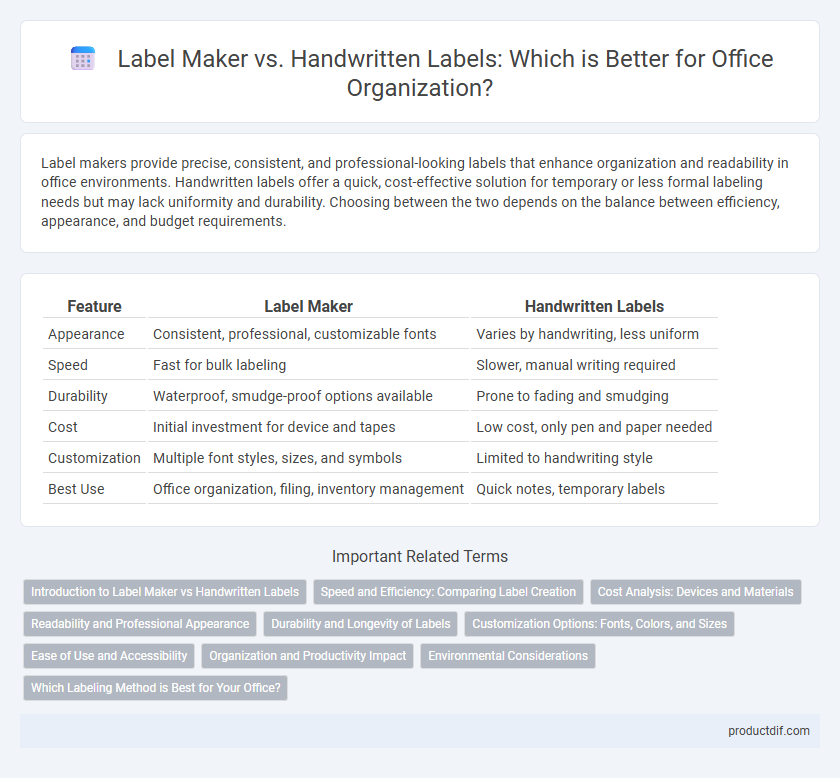Label makers provide precise, consistent, and professional-looking labels that enhance organization and readability in office environments. Handwritten labels offer a quick, cost-effective solution for temporary or less formal labeling needs but may lack uniformity and durability. Choosing between the two depends on the balance between efficiency, appearance, and budget requirements.
Table of Comparison
| Feature | Label Maker | Handwritten Labels |
|---|---|---|
| Appearance | Consistent, professional, customizable fonts | Varies by handwriting, less uniform |
| Speed | Fast for bulk labeling | Slower, manual writing required |
| Durability | Waterproof, smudge-proof options available | Prone to fading and smudging |
| Cost | Initial investment for device and tapes | Low cost, only pen and paper needed |
| Customization | Multiple font styles, sizes, and symbols | Limited to handwriting style |
| Best Use | Office organization, filing, inventory management | Quick notes, temporary labels |
Introduction to Label Maker vs Handwritten Labels
Label makers provide precise, consistent, and professional-looking labels that improve organization and readability in office environments. Handwritten labels, while quick and flexible, often lack uniformity and durability compared to printed labels produced by devices like Brother or Dymo label makers. The choice between label makers and handwritten labels impacts efficiency, print quality, and long-term label maintenance in office supply management.
Speed and Efficiency: Comparing Label Creation
Label makers significantly accelerate the label creation process by producing consistent, legible tags in seconds, outperforming handwritten labels that can be time-consuming and prone to errors. Automated printing technology in label makers enhances overall office efficiency, reducing the need for repetitive corrections and improving organization. Handwritten labels, while flexible for quick notes, often compromise speed and clarity, slowing down workflow in busy office environments.
Cost Analysis: Devices and Materials
Label makers require an initial investment typically ranging from $20 to $150, with replacement tape cartridges costing between $10 and $40 depending on size and type. Handwritten labels incur minimal upfront device costs but involve ongoing expenses for markers, pens, and adhesive labels, averaging $5 to $15 per pack. Over time, label makers often result in lower total costs due to durability and refill efficiency compared to frequent replacement of handwritten materials.
Readability and Professional Appearance
Label makers produce crisp, uniform text that enhances readability and imparts a polished, professional appearance to office supplies, reducing errors in identification. Handwritten labels often vary in legibility and style, which can lead to misinterpretation and a less cohesive office environment. Utilizing label makers standardizes the presentation of labels, improving workflow efficiency and maintaining a consistent corporate image.
Durability and Longevity of Labels
Label makers produce adhesive labels with high durability, resistant to water, fading, and tearing, ensuring longevity in various office environments. Handwritten labels often use paper or tape that wears quickly, smudges easily, and degrades under exposure to moisture or sunlight. For long-term organization, label maker outputs offer superior resilience and maintain readability over extended periods compared to handwritten alternatives.
Customization Options: Fonts, Colors, and Sizes
Label makers offer extensive customization options including a wide range of fonts, colors, and sizes that enhance organization and visual appeal in office settings. Handwritten labels provide limited personalization, relying on available pen colors and handwriting styles, which may vary in consistency. Choosing a label maker ensures uniformity and professional appearance, essential for efficient office supply management.
Ease of Use and Accessibility
Label makers offer superior ease of use with intuitive interfaces, quick printing, and consistent font readability, making them accessible to users with limited handwriting skills. Handwritten labels require no technology, providing immediate accessibility and flexibility but often at the cost of legibility and uniformity. For streamlined office organization, label makers enhance efficiency, while handwritten labels serve well for quick, informal tasks.
Organization and Productivity Impact
Label makers create uniform, easy-to-read tags that enhance organization by enabling quick identification and retrieval of items, reducing time spent searching for supplies. Handwritten labels, while flexible for rapid customization, often lack consistency, leading to potential confusion and slower workflow. Utilizing label makers boosts productivity by maintaining a tidy, systematic environment that supports efficient inventory management and task execution.
Environmental Considerations
Label makers produce consistent, durable labels that minimize waste by reducing the need for frequent replacements compared to handwritten labels, which often use excessive paper and ink due to errors or smudging. Electronic labeling reduces reliance on disposable materials and supports sustainable office practices through recyclable cartridges and energy-efficient devices. Choosing label makers over handwritten labels significantly decreases environmental impact by promoting precision and reducing resource consumption in office supply management.
Which Labeling Method is Best for Your Office?
Label makers offer consistent, professional-looking labels with customizable fonts and sizes, enhancing office organization and efficiency. Handwritten labels provide a quick, flexible solution for temporary or one-off labeling needs but may lack durability and uniformity. Choosing the best labeling method depends on your office's scale and permanence requirements, with label makers ideal for long-term, high-volume use and handwritten labels suited for small-scale, informal tasks.
Label Maker vs Handwritten Labels Infographic

 productdif.com
productdif.com